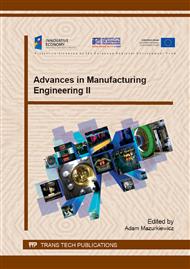p.245
p.251
p.257
p.263
p.271
p.278
p.283
p.289
p.295
Regeneration Method of Aqueous, Technological Liquids Using a Dedicated Microfiltration System
Abstract:
Aqueous technological liquids are widely used in industrial processes. However, due to limited resources, there is an increasing pressure on their protection and reduction of water consumption by, for example, closing water circulation. It is facilitated by the development of membrane technology. The article describes a method for regenerating aqueous technological liquids used in metal surface treatment processes and cleaning a production plant. This process was conducted in batch system using a mobile microfiltration installation. The working unit was equipped with tubular ceramic membranes having a nominal pore diameter of 0.2 μm, working in a cross-flow regime. The main advantage of the apparatus is its low weight and high mobility. The installation and method of regeneration were verified during the processing of a model alkaline liquid used for cleaning a plant in the dairy industry. It was found that microfiltration can be used to remove technological impurities (coagulated proteins and fats) from the liquid. The physicochemical properties of the liquid, including alkalinity, remained stable after repeated filtration. This indicates that the purified liquid can circulate in the system and be used in accordance with its original purpose. The proposed solution enables the reduction of water consumption and chemicals used for the preparation of these liquids.
Info:
Periodical:
Pages:
271-277
Citation:
Online since:
August 2015
Authors:
Price:
Сopyright:
© 2015 Trans Tech Publications Ltd. All Rights Reserved
Share:
Citation:


